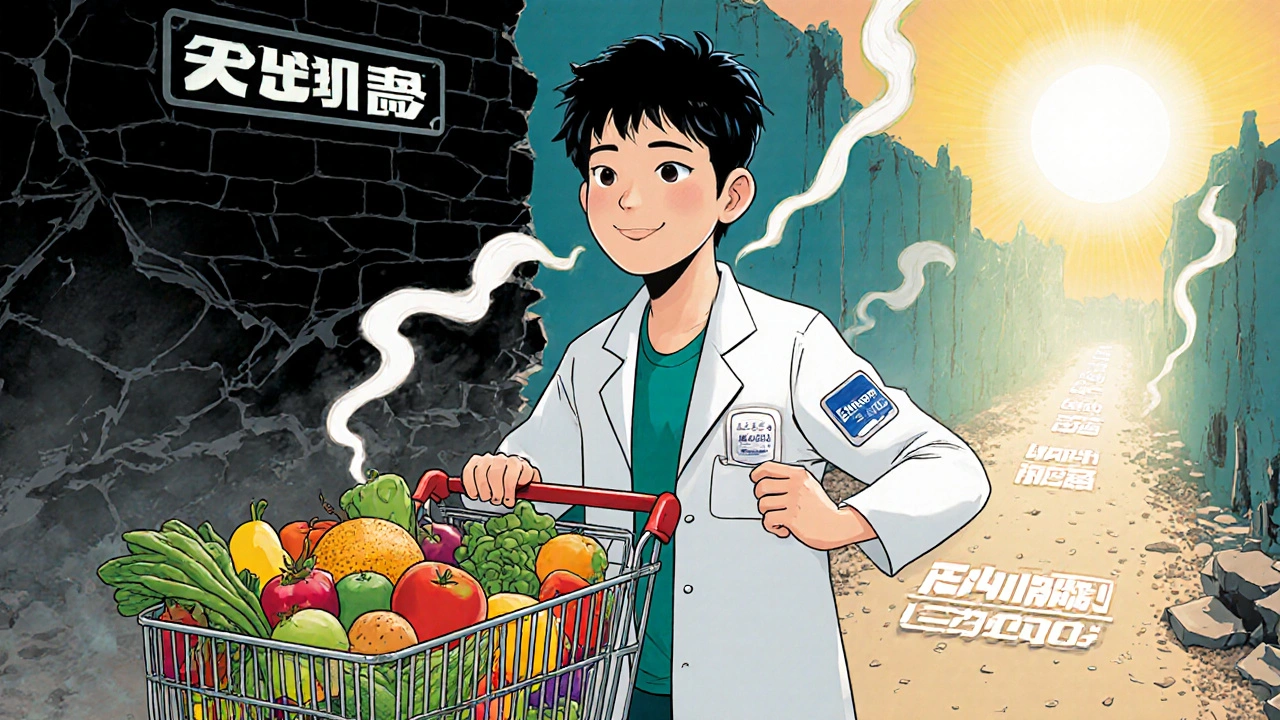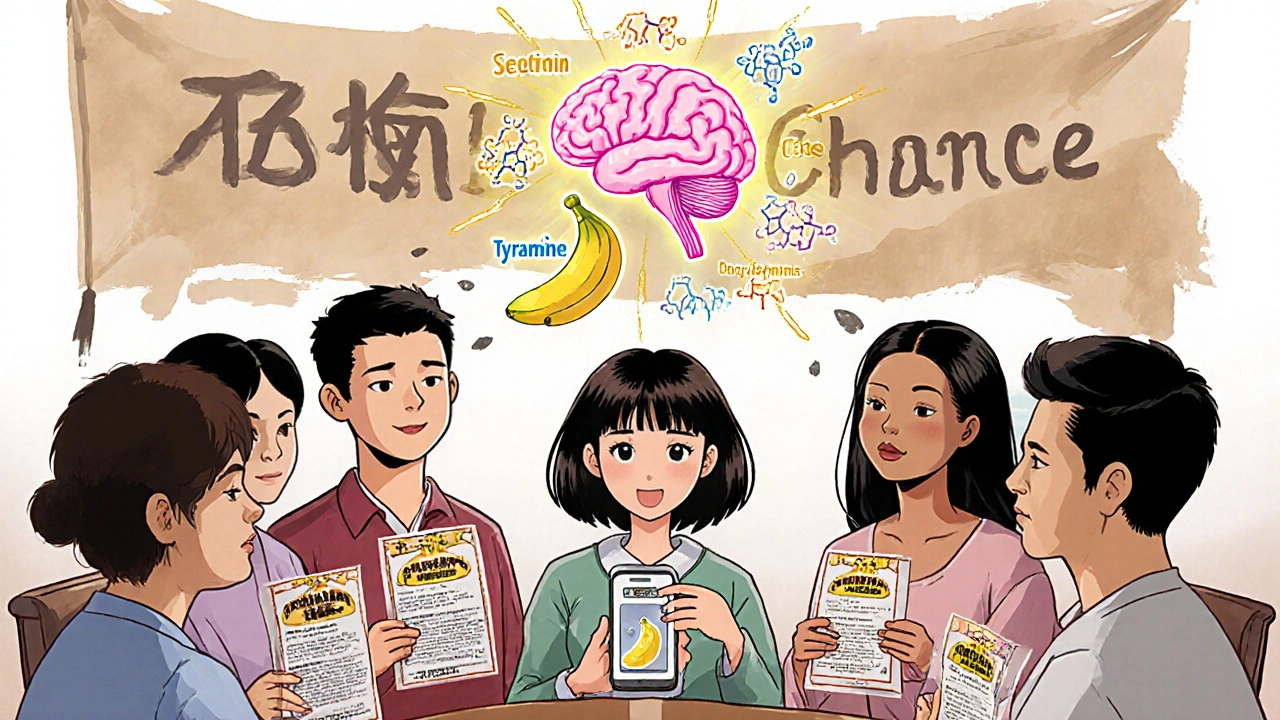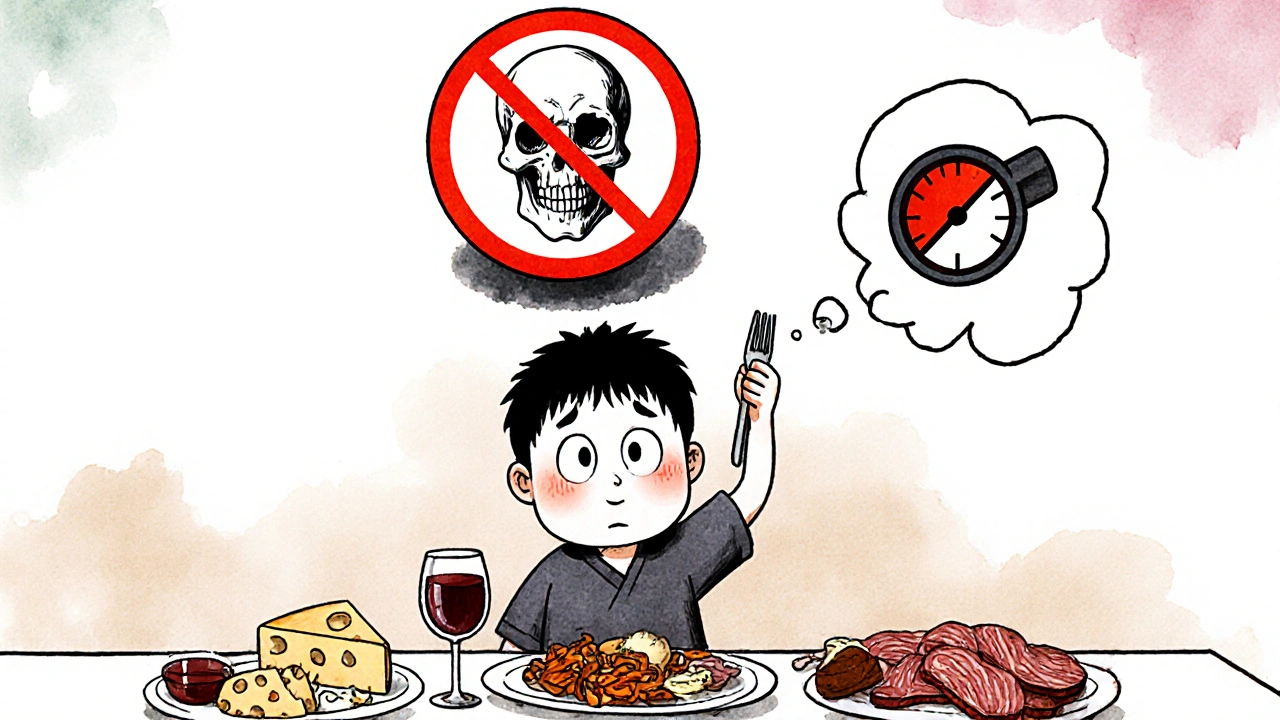Most people start antidepressants hoping for relief without major life changes. But with Monoamine Oxidase Inhibitors (MAOIs), that hope comes with a strict set of rules-rules that can mean the difference between recovery and a medical emergency.
Why MAOIs Still Exist in a World of SSRIs
MAOIs were the first antidepressants ever developed. In the 1950s, doctors noticed patients on iproniazid-a drug meant for tuberculosis-felt unusually happy. That accidental discovery led to the first wave of antidepressant research. Today, SSRIs and SNRIs dominate the market because they’re easier to use. But for about 1 in 5 people with depression that won’t respond to other meds, MAOIs are the last option that works.Unlike SSRIs that target just serotonin, MAOIs block the enzyme that breaks down serotonin, norepinephrine, and dopamine all at once. This broad effect is why they work when others fail. Studies show 50-60% of people with treatment-resistant depression see real improvement on MAOIs, compared to 30-40% with other drugs. For someone who’s tried five antidepressants and still feels numb, that’s not just hope-it’s a lifeline.
The Hidden Danger: Tyramine and the Hypertensive Crisis
The biggest risk with MAOIs isn’t drowsiness or weight gain. It’s a sudden, dangerous spike in blood pressure called a hypertensive crisis. This can happen if you eat even a small amount of tyramine-a compound found in aged, fermented, or spoiled foods.Normally, your gut uses MAO-A to break down tyramine before it enters your bloodstream. But when MAO-A is blocked by the drug, tyramine rushes into your system and forces your body to release stored norepinephrine. The result? Blood pressure can skyrocket to 200/110 or higher in minutes. Symptoms include severe headache, chest pain, blurred vision, nausea, and a pounding heartbeat. In rare cases, it leads to stroke or death.
Common foods that trigger this reaction include:
- Aged cheeses (Parmesan, blue cheese, cheddar over 48 hours old)
- Cured or smoked meats (salami, pepperoni, hot dogs)
- Fermented soy (soy sauce, miso, tempeh)
- Tap beer, red wine, and home-brewed alcohol
- Overripe bananas, avocados, or fava beans
- Leftovers stored more than 24 hours
There’s no safe gray zone. Even a bite of blue cheese or a splash of soy sauce can be enough. A 2022 study found that nearly 30% of MAOI users had at least one hypertensive episode in their first year-often from something as simple as eating leftover pizza or drinking a glass of wine at a dinner party.
Drug Interactions: The Silent Killer
MAOIs don’t just clash with food-they clash with common medications. Taking an SSRI like fluoxetine or sertraline while on an MAOI can cause serotonin syndrome, a life-threatening condition where your body overheats from too much serotonin. Symptoms include confusion, rapid heart rate, muscle rigidity, high fever, and seizures.You need a 2-5 week washout period between stopping one and starting the other. Many patients don’t realize this. A 2022 study in the Journal of Clinical Psychopharmacology found that 15-20% of serotonin syndrome cases linked to MAOIs happened because people switched meds too soon.
Even over-the-counter cold meds can be dangerous. Pseudoephedrine (found in Sudafed) and dextromethorphan (in cough syrups) can trigger dangerous spikes in blood pressure. So can certain painkillers like meperidine (Demerol) and stimulants like Adderall. Always check with your doctor before taking any new pill, supplement, or herbal remedy.

The Newer, Safer Option: The Emsam Patch
Not all MAOIs are created equal. The transdermal patch called Emsam (selegiline) offers a safer alternative. At the lowest dose (6 mg/24 hours), it doesn’t require any dietary changes. That’s because the patch delivers the drug through the skin, bypassing the gut where tyramine usually causes problems.Only when you move to higher doses (9 mg or 12 mg) do you need to follow the same strict diet as oral MAOIs. For many patients, this makes Emsam the preferred choice. About 92% of people on oral MAOIs need full dietary restrictions, but only 8% on the 6 mg patch do.
The downside? Cost. Generic phenelzine or tranylcypromine pills cost $30-$50 a month. Emsam? $850-$1,200. Insurance often covers it for treatment-resistant cases, but many patients still can’t afford it. Still, for those who can, it’s a game-changer.
Life on MAOIs: Real Stories, Real Challenges
Reddit threads and patient forums are full of raw, honest stories. One user, ChronicDepressor87, wrote: “After 12 years of failing every antidepressant, Parnate gave me my life back. Then I ate a slice of blue cheese and ended up in the ER with blood pressure at 220/110.”Another, NeurochemNerd, said: “Dating is impossible. Explaining you can’t have soy sauce on sushi or aged cheese on pizza? It’s not romantic.”
But the flip side? 78% of users who stick with MAOIs report life-changing improvements. They sleep better. They feel joy again. They get out of bed without forcing themselves. In a 2022 survey by the Depression and Bipolar Support Alliance, 65% of MAOI users stayed on treatment for over two years-even with the restrictions-compared to just 42% of those on SSRIs in the same group.
It’s not about being perfect. It’s about being careful. Many patients keep a food diary, avoid restaurants with unknown ingredients, and carry emergency phentolamine (a blood pressure-lowering drug) in their bag. Some even use apps that scan food labels for tyramine content.

Who Should and Shouldn’t Use MAOIs
MAOIs aren’t for everyone. They’re best suited for:- People with treatment-resistant depression who’ve tried at least three other antidepressants
- Those with atypical depression (oversleeping, overeating, heavy limbs, mood reactivity)
- Patients who’ve had success with MAOIs in the past
They’re not recommended for:
- People with uncontrolled high blood pressure
- Those with a history of stroke or heart disease
- Anyone unwilling or unable to follow strict dietary rules
- Pregnant or breastfeeding women (data is limited)
Psychiatrists specializing in treatment-resistant depression are far more likely to prescribe MAOIs than general practitioners. Only 7% of general psychiatrists use them regularly, compared to 38% of specialists.
The Future: Is There Hope for Safer MAOIs?
Researchers are working on new versions. A drug called AZD7325, currently in phase II trials, shows promise in reducing tyramine sensitivity by 70% compared to older MAOIs. If it works, it could make these drugs usable for far more people.The National Institute of Mental Health is also funding studies on MAOIs for bipolar depression, with early results showing a 55% remission rate. That’s significant because bipolar depression is notoriously hard to treat.
Still, experts agree: MAOIs won’t replace SSRIs. But they won’t disappear either. The Lancet Psychiatry found MAOIs are the most effective antidepressants for atypical depression-with a number needed to treat (NNT) of 4.2. That means for every four people treated, one will respond where others failed. That’s powerful.
The key isn’t fear. It’s knowledge. With proper education, monitoring, and support, MAOIs can be used safely. The FDA requires doctors to give patients a detailed medication guide and confirm dietary counseling before prescribing. That’s not bureaucracy-it’s protection.
Can I drink alcohol while on MAOIs?
No. Alcohol, especially red wine, tap beer, and homebrew, can trigger dangerous blood pressure spikes. Even small amounts are risky. Some patients report mild reactions after one glass. It’s not worth the chance. Stick to non-alcoholic drinks.
How long do I need to follow the diet?
As long as you’re taking the MAOI. Even after you feel better, stopping the diet means you’re back at risk. Some people stay on the diet for years. The Emsam patch at the lowest dose is the only exception-no diet needed. But once you increase the dose, the restrictions return.
Are MAOIs addictive?
No. MAOIs don’t cause physical dependence or cravings. But stopping them suddenly can cause withdrawal symptoms like dizziness, nausea, anxiety, and flu-like feelings. Always taper off under a doctor’s supervision.
What if I accidentally eat something with tyramine?
If you feel a sudden headache, chest tightness, or rapid heartbeat, check your blood pressure immediately. If it’s above 180/110, take your emergency phentolamine (if prescribed) and call 911. Don’t wait. Hypertensive crises can escalate fast. Keep your emergency meds with you at all times.
Can I use MAOIs if I have anxiety?
Yes. Many people with treatment-resistant depression also have severe anxiety. MAOIs often help both. In fact, they’re sometimes preferred for anxiety disorders like social phobia or panic disorder because they affect multiple neurotransmitters. But the same dietary and drug interaction rules apply.
What Comes Next?
If you’re considering MAOIs, talk to a psychiatrist who specializes in treatment-resistant depression-not your general doctor. Ask for a referral to a dietitian trained in MAOI safety. Get a blood pressure monitor and learn how to use it. Join a support group like the MAOI Information Project. You’re not alone.MAOIs aren’t for the faint of heart. But for those who’ve tried everything else, they’re not just another pill. They’re a second chance. And with the right preparation, that chance can be lived-safely, fully, and without fear.

Ashley Miller
November 20, 2025 AT 04:59So let me get this straight - we’re giving people a drug that turns their fridge into a death trap and calling it ‘hope’? 🤡 Next they’ll tell me my toaster is ‘medically necessary’ if I don’t eat 3-day-old toast. Classic pharma: make you paranoid about food so you’ll keep buying their $1200 patches. I’m just waiting for the FDA to ban bananas.
Sherri Naslund
November 21, 2025 AT 08:10ugh i hate how people act like this is some deep mystery like ohhh its so hard to avoid cheese but like?? its just food. we used to live without all this overthinking. my grandma ate moldy bread and lived to 98. maybe the real problem is we’re all just too fragile now? 🤷♀️ also why does everyone assume you’re white and middle class? what about people who live on rice and beans? who even has access to blue cheese??
Martin Rodrigue
November 22, 2025 AT 00:56While the article presents a clinically accurate overview of MAOI pharmacology and dietary restrictions, it fails to adequately contextualize the risk-benefit ratio within the broader framework of treatment-resistant depression epidemiology. The statistical emphasis on 50-60% efficacy is misleading without acknowledging the high attrition rate due to non-adherence, which exceeds 40% within the first six months per the 2021 JAMA Psychiatry meta-analysis. Furthermore, the assertion that Emsam is ‘safer’ is technically correct but clinically incomplete - transdermal absorption reduces gastrointestinal MAO-A inhibition but does not eliminate systemic effects, particularly at higher doses. The cost disparity, while significant, reflects patent protection and formulation complexity, not profit maximization alone.
Arun Mohan
November 23, 2025 AT 21:35Wow. So you're telling me that in the land of the free, you can't even have a damn soy sauce dip without risking a stroke? This is why I left the US. In India, we eat fermented stuff since birth - idli, dosa, pickles - and no one's dropping dead. You people turn medicine into a horror movie. Meanwhile, in Delhi, my uncle takes phenelzine with his sambar and still plays cricket at 70. This isn't science - it's fear-mongering dressed up as care.
Tyrone Luton
November 24, 2025 AT 09:48It’s fascinating how we’ve turned medical necessity into a moral performance. You’re not just taking a drug - you’re performing compliance. You’re not just avoiding cheese - you’re proving your worthiness to be healed. The real tragedy isn’t the diet. It’s that we’ve made survival contingent on perfect behavior. What if you’re poor? What if you’re lonely and just want to eat pizza with your friend? We don’t treat addiction like this. Why treat depression like a test you can fail?
Jeff Moeller
November 26, 2025 AT 01:28we dont talk about how the real enemy is the system that makes you choose between your mental health and your social life
you take the pill and lose your friends
you skip the pill and lose yourself
no one says that part
they just hand you a list and say be careful
but no one asks if you can afford to be careful
Herbert Scheffknecht
November 26, 2025 AT 07:14MAOIs are the last bastion of real psychiatry - not the pill-popping, symptom-managing, insurance-approved garbage we get today. SSRIs are like putting a bandaid on a bullet wound and calling it progress. MAOIs don’t mask pain - they rewire the whole damn system. Sure, you can’t have blue cheese. But you can finally feel the sun on your skin again. That’s not a trade-off. That’s a revolution. And if you’re too lazy to read a food label, maybe you weren’t ready to be healed anyway.
Jessica Engelhardt
November 26, 2025 AT 22:59Y’all act like this is some new thing but in the 80s everyone just knew what to avoid - no one needed an app to scan their soy sauce. Now we’ve got millennials crying because they can’t have sushi? America’s gone soft. We used to eat leftovers for three days and not die. You think your depression is worse than my grandma’s? She took Parnate with her fried okra and never missed a church potluck. You’re not sick - you’re entitled.
rachna jafri
November 27, 2025 AT 22:44they don't want you to know this but MAOIs were banned in the 90s because they exposed how pharma profits from SSRIs - they're cheaper to make and you have to take them forever. The tyramine thing? A distraction. They made it scary so you'd never question why your antidepressant doesn't fix anything. The patch? A marketing trick. They want you to pay $1000 so you don't have to think about what's really in your pills. Wake up. This isn't medicine - it's control.
darnell hunter
November 29, 2025 AT 03:55The article exhibits a concerning lack of critical engagement with the methodological limitations of the cited 2022 studies. The Depression and Bipolar Support Alliance survey is non-randomized, self-selected, and subject to significant recall and selection bias. Furthermore, the assertion that 78% of users report 'life-changing improvements' conflates subjective improvement with clinical remission, a distinction not made in the original data. The tone of the piece is emotive rather than evidentiary, and thus fails to meet the standards of scientific communication.
Margaret Wilson
November 30, 2025 AT 06:26OMG I just got Emsam last week and I cried for 20 minutes because I ate a banana and didn't die 😭🌈 I can finally go to Thai food again and not panic! Also I made a playlist called 'MAOI Freedom Vibes' - it has lofi beats and my dog barking. Link in bio. You got this, my beautiful weirdo friends 💖
william volcoff
December 1, 2025 AT 16:52For what it’s worth - I’ve been on Parnate for 4 years. I keep a food journal. I call my pharmacist before trying anything new. I carry phentolamine. It’s a pain. But I haven’t cried in the shower in 3 years. That’s worth the effort. Don’t let the fear scare you off - just be smart. And if you’re struggling with the diet, find a support group. You’re not alone. I promise.
Freddy Lopez
December 3, 2025 AT 00:29There is a deeper philosophical question here: when does medical necessity become a form of social control? The MAOI diet is not merely a biological safeguard - it is a ritual of discipline imposed on the vulnerable. We demand perfection from those who are already broken. Perhaps the true question is not whether we can tolerate tyramine, but whether our society can tolerate suffering without demanding its eradication through compliance.
Brad Samuels
December 4, 2025 AT 03:24I just want to say - to anyone reading this who’s scared or overwhelmed - you’re doing better than you think. I was the guy who panicked over soy sauce. I cried when I had to say no to pizza night. But I kept going. I found a dietitian who didn’t judge me. I made a list of safe snacks. I started a group chat with 3 other MAOI users. It’s not easy. But you’re not broken. You’re just fighting in a world that doesn’t make space for your healing. I see you. Keep going.